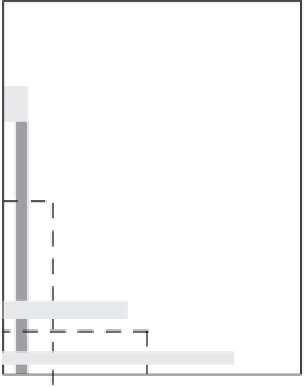Geology Reference
In-Depth Information
isotopic weight, not according to its radioactivity,
or rate of decay. This approach means that one
counts all the carbon atoms in a sample, not just
those that decay, so that the sample size can be
dramatically reduced to a milligram. When AMS
dating was first introduced, it was hoped that
AMS would also allow extension of the age
range of the technique to many more half-lives.
In practice, the technique is still not routinely
capable of extending beyond about 50 ka. Both
commercial and academic labs will run samples
using either the conventional or AMS method.
Although
14
C dating revolutionized archeology
and allowed scientists to establish the absolute
timing from organic remains for the first time in
the 1950s, several pitfalls must be acknowledged.
In order to estimate the age of an object using
14
C,
one must know: (i) the starting ratio of
14
C/
12
C;
(ii) the decay rate; and (iii) the final ratio. We
know the decay rate well, characterized by a half-
life of 5735 years, and can measure the present
ratio well using AMS or can estimate it based on
measured rates of decay. However, because
14
C is
created in the atmosphere by cosmic radiation,
any variations in the production rate of
14
C result
in a different starting ratio in the organic material.
Variations in production rate result from several
sources, chiefly variations in the cosmic-ray flux,
which are associated with fluctuations of the
Earth's and the Sun's magnetic fields. Because
our measurements of these fluctuations have
lasted for only a few decades, we must rely on
calibration. Happily, as mentioned previously,
tree rings provide an organic record that can be
pieced together back several thousand years - in
the case of bristlecone pines, 10 kyr. It is from this
record that we know the
14
C production-rate
record, which is itself of interest to those studying
the magnetic fields of the Sun and Earth. With a
14
Time (ka)
0
10
20
30
15
A
o
14
C Dating
Method
T
1/2
= 5735 years
10
activity = A
o
/2
5
activity = A
o
/8
0
012
3
456
Time (half-lives)
Time (years)
Fig. 3.10
Decay of
14
C concentration with time
follows classic exponential curve.
Shaded bars show transformation of uncertainty in
activities to uncertainties in age. Uncertainties become
very large for low activities. Ages greater than about
seven half-lives cannot be distinguished from infinite
ages. Modified after Olsson (1968).
limitation exists because, if the sample is older
than about seven half-lives, a little less than 1%
((1/2)
7
= 0.8%) of the original
14
C is left in it - so
with the half-life of
14
C being 5735 years, this is
about 40 ka. For example, a gram of modern
carbon experiences about 15 decays per minute.
If this sample were 40 kyr old, it would have
spanned about seven half-lives and would gener-
ate about 15/2
7
= 15/128 decays per minute or
only about 7 decays per hour. Although such low
rates of decay
can
be counted, incoming cosmic
radiation can also trigger the detectors, and con-
sequently causes large uncertainties in the detec-
tor counts attributable to decay of
14
C. (This is
why
14
C labs are often either deep underground
or lead-shielded or both.)
Although measuring the decay rate remains
the dominant (and far cheaper) technique, it has
been augmented tremendously within the last
decade or so by the development of
accelerator
mass spectrometer
(AMS) techniques. In AMS
dating, the carbon is measured according to its
C ratio in hand, from which a radiocarbon age
is calculated using the half-life, one may turn to
published computer codes (e.g., Stuiver and
Reimer, 1993) that allow translation to calendar
years (generating a “calibrated radiocarbon age”).
The problems are largest at young ages, where
the conversion between radiocarbon ages and
calendar ages is typically ambiguous (Fig. 3.11): a
given sample could be either
x
or
y
years old,
owing to a large fluctuation in the
14
C production











































